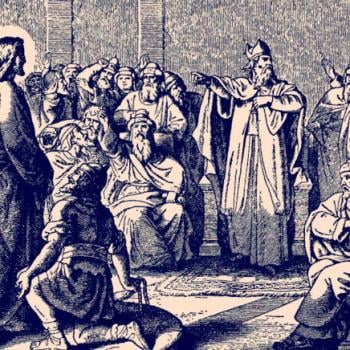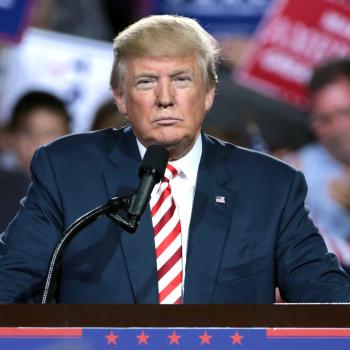Today we’re happy to welcome Mandy McMichael to The Anxious Bench. Mandy is Assistant Professor of Religion at Huntingdon College in Montgomery, AL. She holds a Ph.D. in Religion (American Religious History) from Duke University and is currently revising her dissertation on religion in the Miss America Pageant for publication with Baylor University Press.
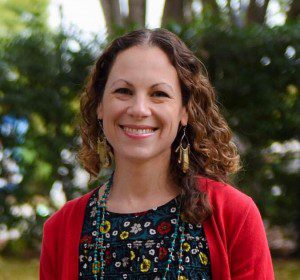 As a historian, I much prefer to study movements than to participate in them. I relish my role as a cultural observer removed from the conflict, uncertainty, and criticism of being in the action. But sometimes one’s faith compels them to act in ways that feel unnatural to them. At least, it did for me. Two weeks ago, I marched.
As a historian, I much prefer to study movements than to participate in them. I relish my role as a cultural observer removed from the conflict, uncertainty, and criticism of being in the action. But sometimes one’s faith compels them to act in ways that feel unnatural to them. At least, it did for me. Two weeks ago, I marched.
Much has already been written about the recent Women’s March on Washington. Some claim it was too white. Others declare it focused on the wrong issues. Some assert that it was too vulgar. Others say it accomplished nothing. We are also seeing many who attended marches assert that it offered precisely the hope, solidarity, and community that they needed after Trump’s inauguration as the 45th President of the United States. And many of these women and men note that the march was not an end in itself, but was instead the beginning of a larger movement for justice. This call for women to occupy the streets of Washington that eventually spread to millions of women marching all over the world, saw itself as the result of – and contemporary to – other struggles for justice.
As is often the case when people stand up and speak out, the Women’s March was met with hate, resistance, misunderstanding, and criticism. As a historian, this came as no surprise to me. Yet, as one of the marchers, it did. I did not understand the gross misrepresentations of the march that I read on social media. Indeed, I was saddened at how many of my friends and relatives vilified the aims of the marchers and how many Christians used this as an opportunity to spew hateful rhetoric rather than trying to understand those with whom they disagreed.
But I should not have been surprised. I had just finished teaching about this very phenomenon.
Last semester I taught a class on Christianity and Civil Rights here at Huntingdon College, a small Methodist institution in Montgomery, Alabama. It was the second time that I have had the opportunity to teach this class in the city known as both the Cradle of the Confederacy and the birthplace of the modern Civil Rights Movement.
Together we read and discuss some of the great texts of the movement: sermons, speeches, and interviews. We begin the course with James Baldwin’s classic The Fire Next Time and end with Charles Marsh’s Beloved Community. In these and other readings, we come face to face with places, churches, and even people that we know. Each time students are baffled to learn how Christians have spoken and behaved hatefully toward one another and how they have employed scripture as a weapon to exclude rather than to love. We are confronted with institutional racism and how it continues to shape the world in which we live. My students do hard work in this class. They ask big questions about faith, justice, and politics and how those things can, do, or should relate.
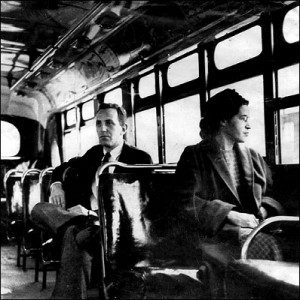
And we also go. We visit the Rosa Parks Museum, the Freedom Rides Museum, King’s church and parsonage, and the Civil Rights Memorial. We walk across the Edmund Pettus Bridge. And as we go, we remember the violence committed, often by Christians, at these sites. We sit with that uncomfortable reality. We listen to those who were alive during the movement. We let ourselves be moved. We reflect on the ongoing struggle for justice for all. We ask what it means to live out Christ’s commandment to love our neighbor as ourselves.
Both times that I’ve taught this course I’ve made the same confession to my students: If I had lived during the Civil Rights era, chances are I would have been part of the silent majority. I am obviously no Rosa Parks, Fannie Lou Hamer, or Ella Baker. But I also doubt that I would have been Juliette Hampton Morgan writing letters to the Montgomery Advertiser about the injustices faced by African Americans or Viola Liuzzo leaving her five children in Michigan to come help with the march from Selma to Montgomery.
My students, passionate justice-seekers that they are, are always a bit shocked by my admission, but it inevitably leads us to fruitful conversation. It is easy to imagine what we would have done or said had we been alive during the Civil War, the fight for women’s suffrage, or the Civil Rights Movement. It is easy to speak out on those incidents of injustice now. But as we reflect on the injustice we see around us and what our faith might compel us to do to combat it, we admit that it’s easier to remain silent or to find fault in those seeking to bring about change in the moment. And we acknowledge that this refusal to understand the Other is still one of the biggest roadblocks to change. Racism did not end with the integration of schools and buses. Access to the polls wasn’t magically granted with the passage of the Voting Rights Act. Gender inequality still exists. Injustice surrounds us. There is still work for us to do. This fall, in the midst of a presidential election, our conversations and proposed actions seemed even more significant.
When the opportunity to attend the Women’s March appeared in my inbox, it was while I was teaching this course. But I am not an activist. At least, that’s what I kept telling myself. I have a fear of crowds. I have two young children. Surely there was something else I could do instead. But like so many others, I could not shake the feeling that I needed to go. In the end, my students’ questions, their fears, their concerns, and their passion were contagious. I did not see how I could say no after I had spent the semester encouraging them to be the change they wished to see in the world.
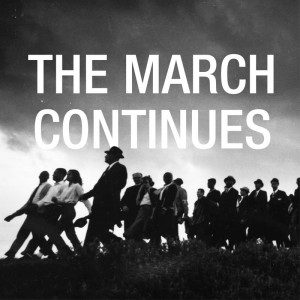
Something last semester reminded me that I have had this option of opting out of social movements because of my privilege. I am a white, middle-class, heterosexual, married Christian woman living in south-central Alabama. I am not at risk nor am I considered a threat. But I have friends who are. And they deserve more than my silence. So I went. I put on my SPLC shirt that reads “The March Continues” and carried a sign that was a replica of a banner from the 1913 Women’s Suffrage March in Washington. I also wore a sash full of names of people for whom I was marching. And I had no doubt that I was exactly where I needed to be on January 21, 2017. That kind of certainty doesn’t come to me often.
Make no mistake, though: what I did was not brave. I was not attacked, beaten, or arrested. Nor was that ever going to happen to me. But, as I stood on the side of the Department of Justice building with a couple of my students, I admit I had a geeky historian moment. Looking around at the crowd, we noted that we were making history. And that felt pretty amazing.
Further Reading about the Women’s March
Dilshad Ali, “Stay Woke: 15 Women and Men on Why They Marched in the Women’s March,” Muslimah Next Door, Jan. 24, 2017
Renee Contreras De Loach, “Why I Marched: A Letter From A Pro-Life, Republican, Anti-Government-Making-Women’s-Decisions, Stay-At-Home Mom,” Women You Should Know, Jan. 24, 2017
Jamilah Lemieux, “Why I’m Skipping the Women’s March on Washington,” ColorLines, Jan. 17, 2017
Dina Leygerman, “You Are Not Equal. I’m Sorry,” The Bigger Picture, Jan. 22, 2017
Jess Zimmerman, “The Myth of the Well-Behaved Women’s March,” The New Republic, Jan. 24, 2017




